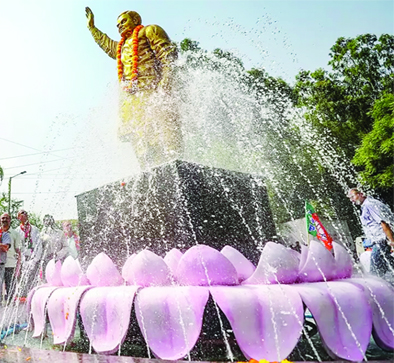Balbir Ram Rattan
It was a historic day on September 03, this month, when a statue of former Prime Minister, Atal Bihari Vajpayee, was unveiled at Atal Chowk, new Radio Station, Panjtirthi in Jammu City, in a colourful programme attended by a large number of people, including prominent social, political and religious personalities.
As per the information available, the funds for the installation of the statue of the one of the great stalwart in Indian politics were provided by the former Deputy Chief Minister Kavinder Gupta from his own pocket and former Deputy Mayor, Jammu Municipal Corporation, Purnima Sharma, had suggested to name the intersection as Atal Chowk, where this statue has been installed.
Atal Bihari Vajpayee, born on 25 December 1924, was an Indian politician, renowned poet and writer, who served three terms as the Prime Minister of India, first for a term of 13 days in 1996, then for 13 months from 1998 to 1999, followed by a full term from 1999 onwards. Vajpayee was one of the co-founders and a senior leader of the BJP. He was a member of the RSS, a nationalist volunteer organization. He was the first Indian Prime Minister not from the Congress to serve a full term in office.
He was a member of the Indian Parliament for over five decades, having been elected ten times to the Lok Sabha and twice to the Rajya Sabha. He was among the founding members of the Bharatiya Jana Sangh (BJS), of which he was president from 1968 to 1972. The BJS with several other parties formed the Janata Party, which won the 1977 general election. In March 1977, Vajpayee became the Minister of External Affairs in the cabinet of Prime Minister Morarji Desai. He resigned in 1979, and the Janata alliance collapsed soon after. Former members of the BJS formed the BJP in 1980, with Vajpayee as its first president.
During his tenure as Prime Minister, India carried out the Pokhran-II nuclear test in 1998. Vajpayee sought to improve diplomatic relations with Pakistan, travelling to Lahore by bus to meet with Prime Minister Nawaz Sharif. After the 1999 Kargil War with Pakistan, he sought to restore relations through engagement with President Pervez Musharraf, inviting him to India for a summit at Agra.
Vajpayee’s Government introduced many domestic economic and infrastructural reforms, including encouraging the private sector and foreign investments, reducing governmental waste, encouraging research and development and privatisation of some government owned corporations. Among Vajpayee’s projects were the National Highways Development Project and Pradhan Mantri Gram Sadak Yojana. It was the Vajpayee government, which launched the Sarva Shiksha Abhiyan campaign, aimed at improving the quality of education.
The Narendra Modi government declared in 2014 that Vajpayee’s birthday, 25 December, would be marked as Good Governance Day, it was a great tribute to the towering personality of Vajpayee and the installation of his statue in Jammu is also a big honour to him.
The installation of the statue in Jammu carry significance as the former Prime Minister Atal Bihari Vajpayee, remained associated with the erstwhile state of Jammu and Kashmir in one way or the other.
A look at the history reveals that Atal Behari Vajpayee was one of the prominent political leaders of the country, who, right from the days of Praja Parishad and Bharatiya Jana Sangh to Bharatiya Janta Party (BJP) remained active in various agitations of this border region of the country. Even during his tenure as Prime Minister of the country, he displayed great concern towards J&K. During ‘Ek Vidhan, Ek Nishan, Ek Pradhan’ agitation, Atal Bihari Vajpayee accompanied Dr. Shyama Prasad Mookherjee, when he entered Jammu and Kashmir without obtaining a permit and was arrested at Lakhanpur.
It was under the Prime Ministership of Atal Bihari Vajpayee that ‘Dogri’ language was included in the 8th schedule of the Constitution of India, a real honour to the mother language of dogras of Jammu and Kashmir.
Installation of the statue of such a great patriot and nationalist figure is a real tribute and it will prove to be a source of inspiration to the people of Jammu and Kashmir.
Trending Now
E-Paper


